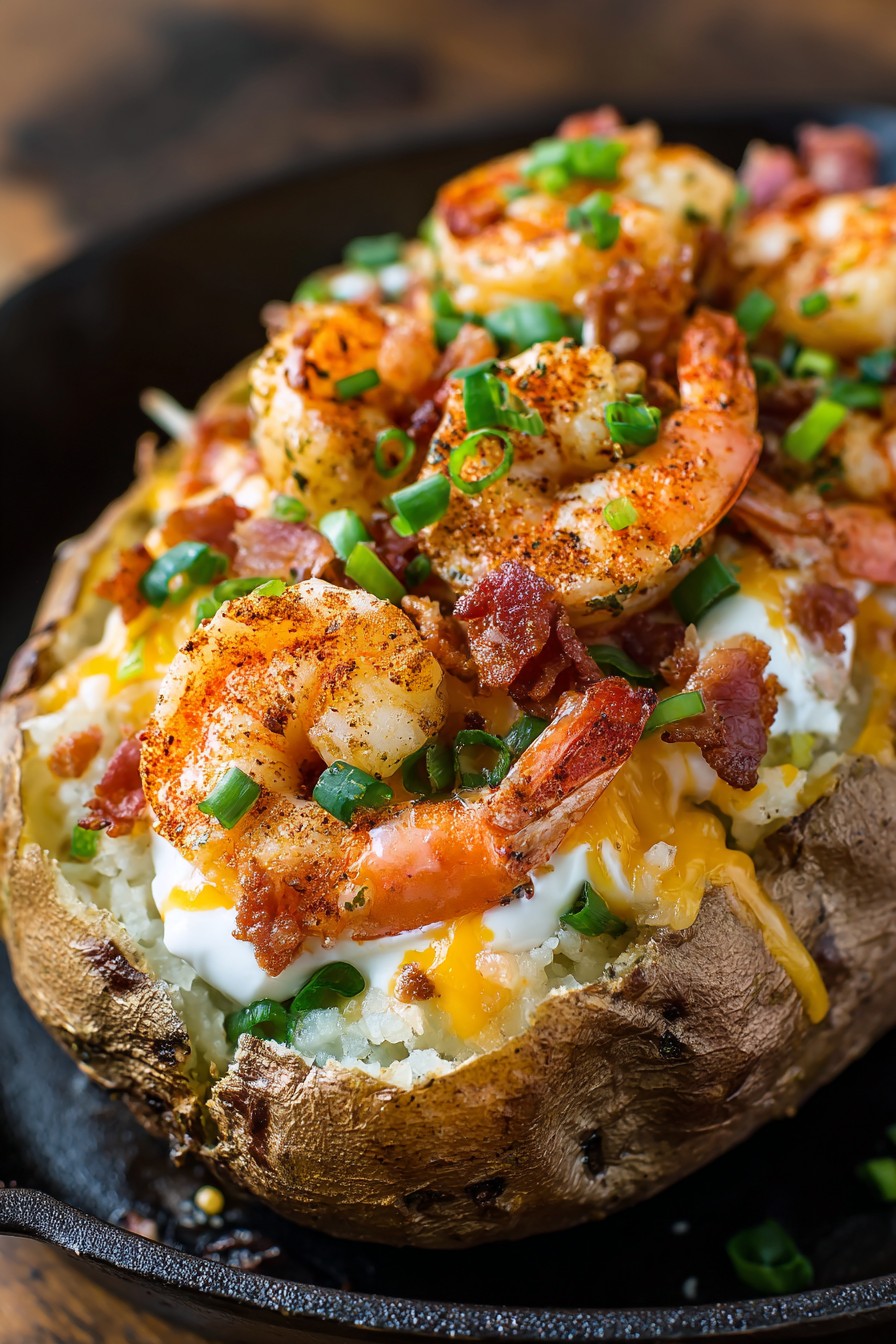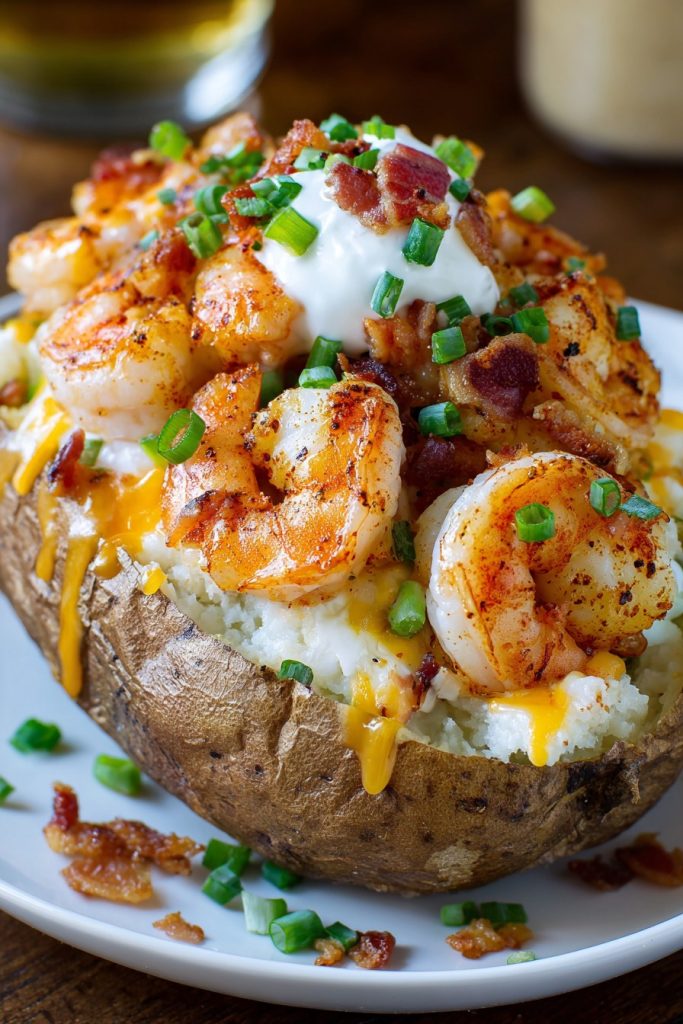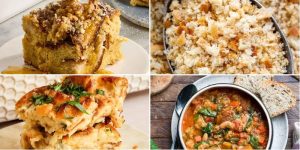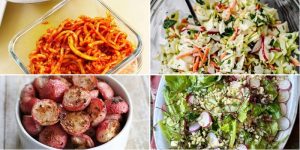Languid coastal breezes from the Gulf of Mexico inspired this culinary creation, where Southern comfort food meets Caribbean spice routes. Last summer’s journey through Louisiana’s bayous revealed how local shrimp fishermen transform humble potatoes into celebratory feasts, blending French Acadian techniques with West African flavor traditions that traveled across oceans to create something uniquely American yet globally resonant.
Why This Recipe Works
- The marriage of starchy russet potatoes with sweet Gulf shrimp creates a textural symphony that dances between creamy interior and crispy skin, reminiscent of Mediterranean coastal cuisine where seafood meets earth’s bounty in perfect harmony
- Cajun seasoning blend, with its complex layers of paprika, garlic, and cayenne, pays homage to the French Quarter’s spice markets while adding depth that transforms simple ingredients into an aromatic journey through New Orleans’ culinary history
- Baking potatoes at high heat mimics traditional clay oven techniques found in Middle Eastern kitchens, creating that coveted crispy skin while maintaining a fluffy interior that perfectly absorbs the garlic butter sauce
- The combination of sharp cheddar and tangy sour cream creates a creamy base that balances the shrimp’s natural sweetness, much like the dairy-seafood pairings found in coastal Italian trattorias where fresh catch meets local cheese
- Fresh chives and green onions add brightness that cuts through the richness, a technique borrowed from Asian culinary traditions where fresh herbs provide counterpoint to savory main components
Ingredients
- 4 large russet potatoes (about 1 pound each), scrubbed clean and dried thoroughly
- 1 ½ pounds large raw shrimp, peeled and deveined with tails removed
- 3 tablespoons olive oil, divided for different cooking stages
- 2 teaspoons Cajun seasoning blend, preferably with smoked paprika notes
- 4 tablespoons unsalted butter, melted until golden and fragrant
- 3 cloves garlic, minced finely to release maximum aromatic compounds
- 1 cup shredded sharp cheddar cheese, freshly grated for optimal melting
- ½ cup sour cream, full-fat for richest texture
- ¼ cup chopped fresh chives, vibrant green parts only
- 4 slices crispy cooked bacon, crumbled into savory bits
- 2 green onions, thinly sliced including tender green tops
- 1 teaspoon sea salt, for seasoning throughout the process
- ½ teaspoon freshly ground black pepper, coarsely cracked
Equipment Needed
- Large baking sheet
- Parchment paper or aluminum foil
- Medium mixing bowl
- Small saucepan
- Sharp chef’s knife
- Cutting board
- Measuring spoons and cups
- Fork for testing potato doneness
- Skillet for cooking shrimp
- Mixing spoon
Instructions

Preparing the Perfect Baked Potato Foundation
Begin by preheating your oven to 400°F, creating the ideal environment for potato skin transformation. Take your scrubbed russet potatoes and pierce each one 6-8 times with a fork, creating steam escape routes that prevent pressure buildup while allowing interior starches to expand properly. Rub each potato thoroughly with 1 tablespoon of olive oil, ensuring every centimeter of skin receives a glossy coating that will crisp beautifully. Sprinkle generously with sea salt, imagining the salt mines of Sicily where this mineral treasure has seasoned Mediterranean cuisine for centuries. Place the potatoes directly on the middle oven rack with a baking sheet positioned below to catch any drips, then bake for 55-65 minutes until skins are crackly and a fork inserts effortlessly through the center. The potato should feel light and fluffy when squeezed with oven mitts, indicating perfect internal steam development. This technique mirrors how street vendors in Lisbon prepare their legendary baked potatoes, achieving that magical contrast between crunchy exterior and cloud-like interior.
Creating the Garlic Butter Shrimp Symphony
While potatoes work their oven magic, prepare the shrimp component that elevates this dish from simple to spectacular. In a medium bowl, combine peeled shrimp with remaining 2 tablespoons olive oil and Cajun seasoning, massaging the spices into each crustacean until they wear a vibrant reddish-orange cloak. Let this marinate for 15 minutes, allowing the spices to penetrate deeply while you prepare the garlic butter sauce. In a small saucepan over medium-low heat, melt the butter slowly until it develops tiny golden bubbles, then add minced garlic and cook for exactly 90 seconds until fragrant but not browned, releasing those essential oils that form the flavor foundation of countless Mediterranean dishes. Heat a large skillet over medium-high heat until a water droplet sizzles dramatically, then add the marinated shrimp in a single layer, cooking for 2-3 minutes per side until they curl into tight C-shapes and turn opaque with beautiful pink coloration. The shrimp should release easily from the pan surface when properly seared, a technique perfected in coastal Greek kitchens where seafood meets hot metal with satisfying sizzles.
Assembling the Flavor Architecture
Remove the perfectly baked potatoes from the oven and let them rest for 5 minutes until cool enough to handle but still steaming hot inside. Using a sharp knife, slice each potato lengthwise about three-quarters through, then gently squeeze the ends toward the center to create a natural opening that reveals the fluffy interior, much like opening a treasure chest of starchy goodness. Fluff the potato flesh with a fork, creating textured peaks and valleys that will capture the upcoming toppings beautifully. Begin building your flavor structure by spreading 2 tablespoons of sour cream evenly across each potato’s surface, allowing the creamy tang to melt into the hot flesh. Sprinkle ¼ cup of shredded cheddar cheese over each potato, watching it begin to melt immediately from the residual heat, creating that glorious cheese pull reminiscent of Swiss raclette traditions. This layering technique ensures every bite contains multiple textures and temperatures working in harmonious concert.
Pro Tip: For extra crispy potato skins, rub with oil and salt before baking, then place directly on the oven rack rather than a baking sheet to allow maximum air circulation around every surface.
The Grand Topping Finale
Pro Tip: Let potatoes rest for 5 minutes after baking before cutting open – this allows starches to set properly and prevents the interior from becoming gummy when mixed with toppings.
Serving with Global Flair
Presentation transforms this dish from mere sustenance to culinary experience, so consider your serving vessel carefully. Transfer each loaded potato to individual warmed plates, perhaps rustic ceramic that echoes Mediterranean pottery traditions. Serve immediately while the cheese remains molten and the shrimp retain their perfect texture, as timing is crucial for optimal enjoyment. Consider accompanying with a simple green salad dressed with lemon vinaigrette to provide acidic contrast, or roasted vegetables that continue the baked theme. For beverage pairings, a crisp Sauvignon Blanc with citrus notes complements the shrimp beautifully, or if preferring non-alcoholic options, sparkling water with lime mirrors the coastal inspiration. The first cut with your fork should reveal steaming potato fluffiness merging with cheese pull and shrimp tenderness, creating that multisensory experience found in the world’s best seafood restaurants from Marseille to Miami.
Pro Tip: Cook shrimp just until they form tight C-shapes and turn opaque – overcooking makes them rubbery, while undercooking risks food safety. The perfect shrimp should have slight resistance when bitten.
Tips and Tricks
For those seeking to elevate this dish from excellent to extraordinary, consider these advanced techniques drawn from global culinary traditions. When selecting potatoes, seek out Russet Burbank varieties specifically, as their high starch content and thick skins create the ideal textural contrast – this knowledge comes from Idaho potato farmers who’ve perfected baking varieties over generations. For supremely crispy skins, after oiling and salting, rub the potatoes with a mixture of cornstarch and salt before baking, a technique borrowed from Chinese cooking that creates incredible crunch. When preparing shrimp, if using frozen varieties, thaw them slowly in the refrigerator overnight rather than quick-thawing in water, as this preserves their natural sweetness and firm texture, much like Japanese sushi masters handle their seafood. For the garlic butter sauce, consider infusing the butter with one sprig of fresh thyme or rosemary during the melting process, then removing before adding garlic – this adds herbal complexity reminiscent of Provençal cuisine. If your potatoes vary in size, test doneness by inserting a metal skewer into the largest one – it should meet no resistance when fully cooked, a method used by professional chefs to ensure consistent results. For cheese lovers, blend sharp cheddar with a small amount of smoked gouda or pepper jack to create more complex flavor profiles, taking inspiration from Swiss fondue traditions where cheese blending is an art form. When baking multiple potatoes, ensure they don’t touch on the oven rack to allow proper air circulation, and rotate them halfway through cooking for even browning, techniques perfected in French boulangeries for consistent results. For meal prep enthusiasts, you can bake potatoes in advance and reheat them at 350°F for 15 minutes before loading – the texture holds remarkably well, a secret known to busy Italian nonnas who plan ahead without sacrificing quality. Finally, for presentation perfection, garnish with microgreens or edible flowers just before serving, adding restaurant-level elegance that transforms this humble dish into a centerpiece worthy of any international dinner table.
Recipe Variations
- Caribbean Jerk Shrimp Potato: Replace Cajun seasoning with authentic Jamaican jerk spice blend, adding 1 tablespoon brown sugar to the marinade for caramelization. Include diced pineapple and red bell pepper in the topping mixture, then finish with fresh cilantro and lime wedges. This variation channels the vibrant energy of Montego Bay street food markets where sweet heat dominates the flavor landscape.
- Mediterranean Lemon Herb Version: Use oregano, thyme, and lemon zest instead of Cajun seasoning for the shrimp marinade. Substitute feta cheese for cheddar and Greek yogurt for sour cream, then add kalamata olives, diced cucumber, and cherry tomatoes. Drizzle with extra virgin olive oil and fresh dill, transporting your taste buds to a seaside taverna in Santorini.
- Asian Fusion Interpretation: Marinate shrimp in soy sauce, ginger, and sesame oil instead of Cajun spices. Top with sriracha mayo, pickled ginger, and crispy fried shallots. Substitute mozzarella for cheddar and add edamame and shredded nori, creating a East-meets-West fusion that would feel at home in Honolulu’s innovative food truck scene.
- Southwestern Chipotle Twist: Use chipotle powder and cumin in the shrimp seasoning for smoky heat. Replace cheddar with pepper jack cheese and sour cream with Mexican crema. Add black beans, corn, and avocado slices, then garnish with fresh cilantro and lime crema, capturing the essence of Santa Fe’s vibrant culinary traditions.
- Seafood Medley Luxury: Combine shrimp with equal parts scallops and lump crab meat. Use Old Bay seasoning instead of Cajun blend and substitute havarti cheese for cheddar. Add lemon butter sauce and fresh parsley, creating an indulgent experience reminiscent of New England shore dinners where ocean bounty takes center stage.
Frequently Asked Questions
Can I prepare the components ahead of time for easier assembly?
Absolutely, and this approach actually enhances certain elements when done strategically. You can bake the potatoes up to two days in advance, storing them refrigerated in an airtight container, then reheating at 350°F for 20 minutes before loading – this method actually improves texture by allowing starches to retrograde. The shrimp can be marinated overnight in the refrigerator, developing deeper flavor penetration much like ceviche preparation techniques. The garlic butter sauce can be made 3 days ahead and gently reheated, with the flavors melding beautifully over time. However, assemble the final dish just before serving to maintain optimal textures, as the contrast between hot potato, melting cheese, and perfectly cooked shrimp creates the magic. This make-ahead approach mirrors how professional kitchens operate, with mise en place preparation ensuring flawless final execution during service.
What’s the best way to reheat leftovers without compromising quality?
Reheating requires careful technique to preserve textures, as microwave use often turns shrimp rubbery and potatoes soggy. Instead, preheat your oven to 325°F and place the loaded potato on a baking sheet. Cover loosely with aluminum foil to prevent excessive browning and heat for 15-20 minutes until warmed through. For crispier results, remove the foil for the final 5 minutes. Alternatively, you can disassemble the components and reheat separately: potatoes in the oven, shrimp quickly in a skillet, then reassemble. This method, though more involved, preserves the individual perfect textures of each element. The careful reheating process honors the ingredients’ integrity, much like how French chefs approach leftover transformation with respect for original quality.
Can I use frozen shrimp, and how does it affect the final result?
Frozen shrimp work excellently when handled properly, as most “fresh” shrimp at markets were previously frozen anyway. Choose individually quick frozen (IQF) shrimp without added sodium solutions, which can create watery texture. Thaw slowly in the refrigerator overnight rather than using water methods, which leach flavor and affect texture. Pat thawed shrimp thoroughly dry with paper towels before marinating to ensure proper searing and flavor adhesion. The quality difference between properly handled frozen shrimp and fresh is minimal, and frozen often provides better value while maintaining food safety. This practical approach reflects global seafood distribution realities, where freezing at sea preserves quality better than extended fresh transportation.
Are there vegetarian alternatives that maintain the dish’s essence?
Certainly, and creative vegetarian versions can be equally satisfying while honoring the original concept. Replace shrimp with seasoned portobello mushroom strips or breaded eggplant slices, using the same Cajun seasoning and cooking method. For protein-rich alternatives, marinated and pan-seared tofu or tempeh work beautifully, absorbing the garlic butter sauce wonderfully. Consider adding plant-based bacon alternatives or smoked paprika for that umami depth. The potato and cheese foundation remains unchanged, providing familiar comfort while the toppings venture into new territory. This adaptability demonstrates how global recipes evolve across dietary preferences, maintaining their soul while embracing innovation, much like how Indian street food vendors create both meat and vegetable versions of popular dishes.
What wine pairings complement this dish best?
The complex flavor profile invites several excellent pairing options depending on which elements you want to highlight. A crisp Sauvignon Blanc with citrus notes cuts through the richness while complementing the shrimp’s sweetness, much like coastal Italian pairings. For red wine lovers, a light Pinot Noir with bright acidity stands up to the Cajun spices without overwhelming the seafood. Rosé provides wonderful versatility, bridging the gap between white and red while handling both the potato’s earthiness and shrimp’s delicacy. For non-alcoholic options, sparkling water with lime mirrors the coastal theme, or ginger beer provides spicy contrast that enhances the Cajun seasoning. These pairing considerations reflect how sommeliers approach complex dishes, finding beverages that either contrast or complement dominant flavors.
Summary
This loaded shrimp baked potato masterpiece blends Gulf Coast seafood traditions with global culinary techniques, creating a harmonious dish where crispy-skinned potatoes meet spice-kissed shrimp in garlic butter embrace. The recipe balances textures and flavors while offering endless customization possibilities, making it equally suitable for weeknight dinners or impressive entertaining. Each component honors its cultural origins while uniting in delicious synergy.
Loaded Shrimp Baked Potato
4
servings20
minutes65
minutesIngredients
Instructions
- 1 Preheat oven to 400°F. Pierce potatoes with fork, rub with 1 tablespoon oil and salt. Bake 55-65 minutes until tender.
- 2 Marinate shrimp with remaining oil and Cajun seasoning for 15 minutes.
- 3 Melt butter with garlic in saucepan, cook 90 seconds until fragrant.
- 4 Cook shrimp in skillet 2-3 minutes per side until opaque and curled.
- 5 Slice baked potatoes open, fluff flesh, layer with sour cream, cheese, shrimp, bacon, and herbs. Drizzle with garlic butter sauce.



